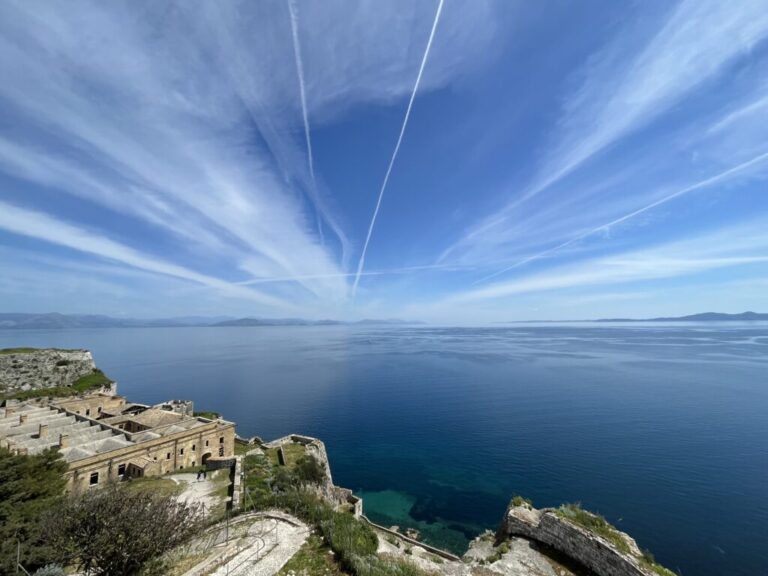In a time before time, the great god Cronus castrated his father Ouranos with a sickle. Like a tyro gangster, who flings away his smoking gun in horror, he dropped the bespattered sickle in the Ionian, where it became the sickle-shaped island of Corfu. And the severed balls? They formed the two hills of the headland that is your first glimpse of Corfu Town from the sea.
For me, that sight is one of the best — those hillocks topped by the Venetian battlements of the Old Fort — just as Corfu Town is one of the best places in the world. It’s the fact that it’s underrated, to begin with. The tourists who arrive by plane either go south, skipping it altogether, or, heading north, they skirt it, blearily oblivious of what it is they’re missing.
What are they missing? A haphazard Italian town, which seems to have been transplanted from Tuscany to this island off the northwest coast of Greece. The oldest part is a lovely anachronism of labyrinthine streets and twittering Alpine swifts. Romeo and Juliet balconies lean towards one another across narrow alleyways, as if to whisper along the dripping lines of laundry. Tufts of wild grasses grow out of the facades of palazzos. The streets are graffitied and nameless, continually surprising. It’s almost impossible not to get lost.
Lawrence Durrell, Gerald Durrell’s brilliant older brother, fell in love with the place and sketched it in Prospero’s Cell, his memoir of living in Corfu in the 1930s. He describes weekly evenings with fellow writer-types at a taverna called The Sign of the Partridge. There the Armenian poet Kostan Zarian recited the To be or not to be speech in six languages, none of which was English. Elsewhere, an erudite character, sinsisterly dubbed Count D, declares that they are all sketching Corfu, but, trapped by their subjectivity, none will tell the whole truth.
For example, he informs the naturalist Theodore Stephanides that his account will leave out the “beautiful mother of the Gorgons in the Museum”. To make good that omission, I’ll mention it. The Gorgon Pediment in Corfu Town’s Archaeological Museum, which dates from c.590BC, once fronted the nearby Temple of Artemis. It’s not only the finest such carving we have from the period. It’s also, to my knowledge, the earliest example of a fascinatingly self-referential sculptoral subject: a stone rendering of a monster whose gaze turns you to stone.
Later artists have seemed aware of the fact that they’re gorgonising the gorgon. In Cellini’s Perseus with the Head of the Medusa, he conceals a pareidolic portrait of himself in the back of the hero’s helmet. In Caravaggio’s painting of the gorgon, the monster’s face is, frankly, the artist’s own. The Medusa in the museum seems aware of this, too. She grins at the joke, while, legs spread in pinwheel fashion, she runs at full tilt, either towards the viewer threateningly, or perhaps in fear away from the sculptor.
It’s a conundrum for a travel writer, this thought that you’ll never capture a place as it really is. But it’s liberating too. Maybe the best I can do is not even try to summarise such a chaotic history; not to mention the three Ottoman sieges of the town, none of which succeeded; not to include the brief era of the French, when the Golden Book, listing the names of the noble families of Corfu, was burned in the city square; not to talk about the time of the British, of the vain governor Sir Frederick Adam and his moustachioed wife, or the unofficial colonial jester, the poet and painter Edward Lear, who once saluted the passing soldiers, forgetting he had paintbrushes in his hand, and smeared his beard all the colours of the rainbow.
Instead, I should stick to safer ground, and share personal recollections, which no one can contradict. Soon after my son was born, I stayed here for a month, and would come early to work in the Liston, the long loggia of cafes at the front of the town. By 10am, when the waiters lowered the awnings with a windlass, it would be getting too hot to think, and I would descend past the old Governor’s Palace to a tiny beach. This being anarchic Corfu Town, there was no one charging for recliners. There were no recliners.
I would sit in the furthest corner in a patch of shade, my feet in the cool water, and continue writing. Nearby, on a rock, three elderly Greek women gossiped. Each had a plastic bag of sea urchins she had collected. One time, the surging wake of a passing ferry caught them offguard and they were scattered like ninepins, their urchins escaping gratefully into the water.
Around the corner, at the water’s edge, there’s a tiny shrine to the Big-Eyed Virgin. It is hung with tamata, little placards of beaten silver left as offerings. If you have a bad leg, the tama is illustrated with a leg; if you’re suffering from conjuctivitis, you leave one that shows an eye; and so on. More recently, I and my partner Georgia bought a tama showing a child, and left it at the sarcophagus of St Spiridon, the patron saint of the island. Later, at the flea market in Athens, we bought a selection of used tamata, which now hang from our Christmas tree.
I realise it’s futile to try to capture the spirit of a place. These snapshots — the snatches of music heard in the evenings from the town’s many orchestras, or the sight of a tourist waving away a wasp and inadvertently attracting the attention of a waiter — are just snapshots. Similarly, it’s futile to look for the life described in Prospero’s Cell. Lawrence Durrell is dead. The Sign of the Partridge no longer exists. If anyone, on reading this, visits Corfu Town, they’ll find an entirely different place. Yet this, for what it’s worth, is the one I know.

